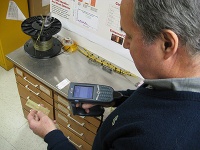The sensor could report a dangerous level of impact to a football helmet on a player who shows no signs of a concussion, prevent a passport from being read by thieves, or even tell you if someone has tampered with your wine or prescription drugs.
Kauffman and senior research physicist Doug Wolf created the SMART (Status and Motion Activated Radiofrequency Tag) sensor under FAA funding for use in ’smart clamps’ to hold aircraft wiring in place.
Designed to replace traditional clamps, the new technology uses a simple radiofrequency identification (RFID) tag that will ’talk’ to a handheld reader if a clamp has been compromised, putting the wires - and thus the aircraft - at risk.
A typical commercial aircraft has miles of wiring secured in bundles by hundreds of thousands of clamps, Kauffman said. By keeping bundled wire secure and out of the way, the clamps also keep wires from rubbing against one another or against the aircraft fuselage - which could lead to a break in the insulation. An exposed wire could prove catastrophic because of its potential for sparking, especially if it is in the presence of fuel.
But clamps can wear and break over time, and wires can get pinched between the clamp ends when they are first tightened. Either way, there is a danger that a wire or its insulation could fray or break.
Finding broken clamps can be tricky because of the sheer volume of clamps within an aircraft and because they are often in locations not easily accessible to maintenance personnel. ’So we started looking for a way to quickly and easily find out if a clamp is broke or did not fully close properly in the first place, and came up with the idea of using RFID tags,’ said Kauffman.
Radiofrequency identification tags are commonly used to track packages and devices such as anti-theft tags on clothing and other consumer goods. An RFID reader sends out radio waves to a a microchip sensor embedded in the tag. The sensor’s antennae use the radio waves to power the microchip, so it can, in turn, send stored information back to the reader.
But Kauffman modified the tag to include a bypass around the chip, preventing the chip from being read unless the bypass is broken.
’RFID tags are designed to always respond, which means they’ll keep talking until they fail,’ he said. ’The SMART sensor works oppositely. We call it status-activated, because it will only talk if there is a change in the status of the sensor. In other words, it can only be read if it the sensor bypass is breached.’
The modification would allow maintenance personnel to quickly pass a handheld RFID reader through the body of an aeroplane to listen for broken clamps, Kauffman said, adding that SMART clamps could be used throughout a plane or installed only in ’hot spots,’ such as near hydraulic lines, fuel tanks or anywhere else a loose wire could jeopardise the aircraft.

’If we used traditional RFID technology, thousands of good clamps would be talking, making it very difficult to find a broken one among them,’ Kauffman said. ’Using SMART sensors, as long as the reader does not get a signal, all is well. If you get a signal, the tag’s identity enables you to quickly find the broken clamp.’
That same technology could be used to tell if a composite aircraft panel has sustained a sub-surface crack or, in a completely different venue, whether a football player has suffered a blow to his helmet severe enough to cause a concussion, even if he doesn’t show symptoms, Kauffman said. ’With only minor variations to the design or material of the microchip bypass, SMART sensors could be used to detect and report hidden impact damage, cracks, temperature changes, corrosion or tampering in any number of products and devices.’
Kauffman added that SMART components, at less than 50 cents (32p) per tag, are already inexpensive enough that they could be manufactured and placed inside existing as well as new football helmets. ’The sensors could be designed to measure different levels of impact, depending on the size of the players, and would only talk to the reader if a helmet sustained enough force to be dangerous.’
The SMART technology could also make it difficult for identity thieves to steal personal information from electronic passports. ’Right now anyone with a miniature reader can stand close to you and scan your unprotected e-passport while it’s closed and in your pocket or purse. But a passport that contained a SMART tag rather than a traditional RFID tag could only be scanned when opened, allowing appropriate personnel to read it.’
Numerous other potential uses include detection and report of: tampering with electronics, wine seals, pharmaceutical containers and other packaging; exposure to temperatures not safe for vaccines or frozen foods - even briefly - during storage or transit; unsafe tyre-tread wear; and hidden corrosion in equipment and structures such as aircraft and bridges, or biocorrosion in fuel and foods that have become contaminated.
Kauffman is currently identifying licensees to bring variations of the SMART technology to market.





Project to investigate hybrid approach to titanium manufacturing
What is this a hybrid of? Superplastic forming tends to be performed slowly as otherwise the behaviour is the hot creep that typifies hot...